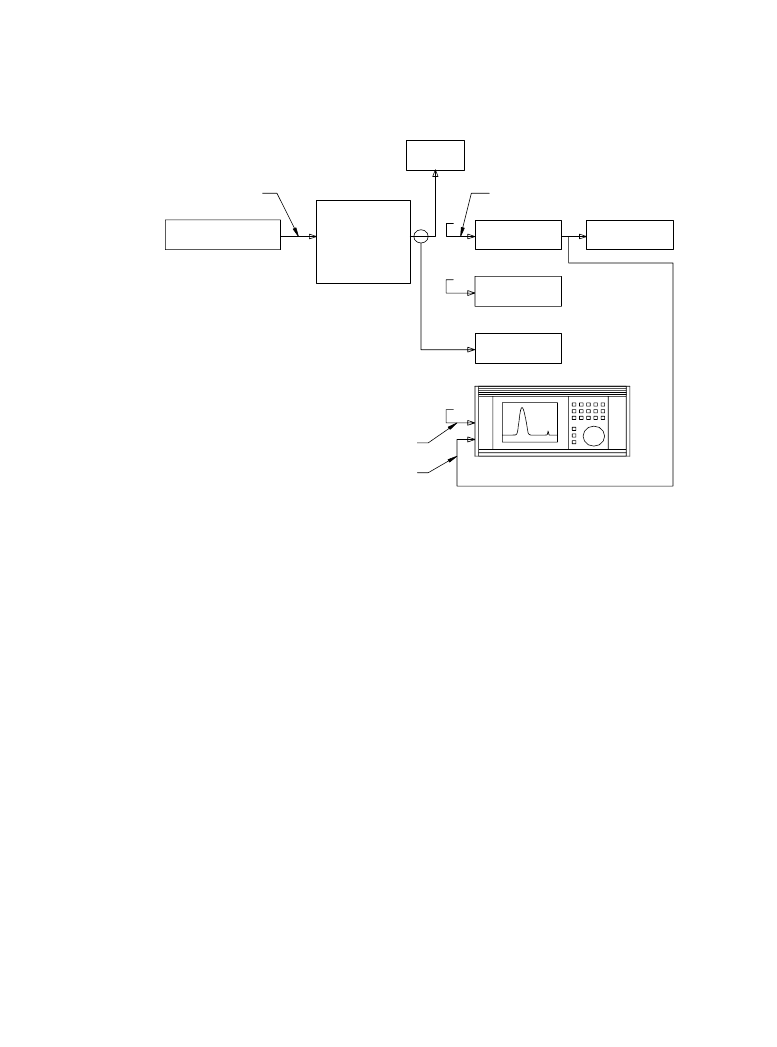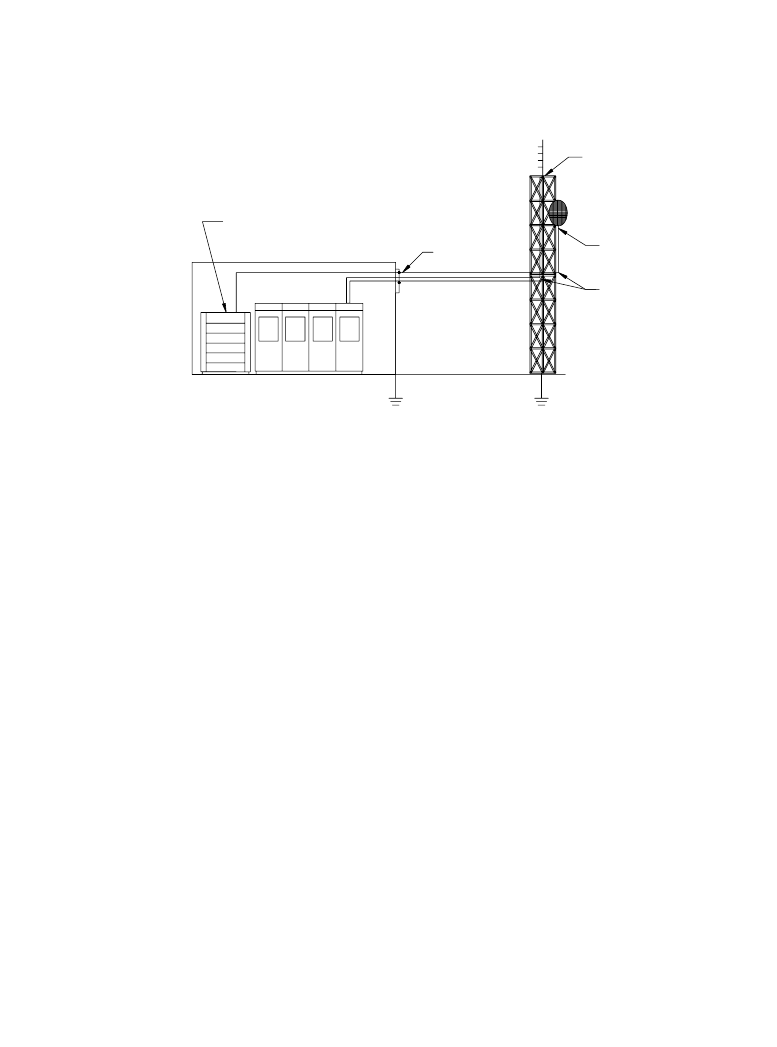ВУЗ: Казахская Национальная Академия Искусств им. Т. Жургенова
Категория: Книга
Дисциплина: Не указана
Добавлен: 03.02.2019
Просмотров: 21655
Скачиваний: 19

Radio STL Systems 11-97
Figure 11.4.25 shows a typical bench test setup for an STL system.
Planning Cable Runs
Routing of the transmission line from the transmitter to the antenna is an often overlooked ele-
ment of STL installation. Confirm that there is a practical route for the coax from the transmitter
to the rooftop or tower location. Double-check the length of the transmission line path at both the
studio site and the station transmitter site. If the actual run is longer than predicted during fade
margin calculations, run the numbers again to be certain that a problem will not develop during
system commissioning. Confirm also that the pigtail cables to be used are sufficiently long and
have the proper connector terminations.
11.4.3e
Installation
The locations commonly used for broadcast transmitter sites are seldom ideal from an environ-
mental standpoint. The site may be difficult to reach during certain parts of the year, very hot
during the summer, and very cold during the winter. For these reasons, rugged equipment should
be chosen and properly installed. Temperature extremes can cause problems for frequency-deter-
mining elements, as well as accessories such as cavity filters, preselectors, and preamplifiers.
Environmental control at the broadcast transmitter site, therefore, is highly recommended.
The STL transmitter and receiver should be mounted in an equipment rack in a protected
location adjacent to the stereo generator at the studio site, and adjacent to the exciter at the
Signal generator
STL
transmitter
STL receiver
Distortion
Power
meter
Load
Input signal
RF sample
counter
Frequency
Analyzer
Spectrum analyzer
RF signal input
Baseband signal input
Figure 11.4.25
Equipment setup for bench testing an STL system prior to installation. (
After [2].)
Downloaded from Digital Engineering Library @ McGraw-Hill (www.digitalengineeringlibrary.com)
Copyright © 2004 The McGraw-Hill Companies. All rights reserved.
Any use is subject to the Terms of Use as given at the website.
Radio STL Systems

11-98 Broadcast Transmission Systems
broadcast transmitter site. Keep all cable runs as short and direct as possible. Excessive cable
lengths between the stereo generator and the STL transmitter, or between the STL receiver and
the exciter, can degrade stereo separation and frequency response. Follow good grounding prac-
tices at all times.
The antenna presents probably the greatest installation challenge. Because of its directional
nature, the antenna must be properly oriented. Compass bearings are desirable along with what-
ever visual sightings are practical. The received signal strength at the broadcast transmitter site
can be used as an indication of proper orientation of the STL receive antenna. Ensure also that
the antenna is set to the proper angle relative to the horizon. Because the STL antennas may be
located high on a tower or building, a professional tower crew may be required to mount the
devices. Make certain that all cables on the tower are securely fastened to prevent stress and
wear. Seal the external connections with sealant made for that purpose and completely wrap the
connection joints with tape.
While it is desirable to mount the receive antenna high on a tower to ensure a good path, it is
also good engineering practice to keep the antenna as far as possible from radiating elements on
the structure, such as the station's main broadcast antenna. Other potential sources of RF prob-
lems include 2-way radio, cellular radio, and TSL systems. If the STL receive antenna is located
in a strong RF field, the front-end may be overloaded or desensitized. Placing the STL antenna
close to other antennas on the structure also can detune the antennas, degrading the performance
of both systems.
One of the most common problems encountered during installation is damage to the transmis-
sion line. Lines must not be twisted or bent beyond their minimum bending radius. To retain its
characteristic impedance, the line must be treated with care. A line damaged by carelessness can
cause poor performance of the system.
The transmission line must be properly grounded. As illustrated in Figure 11.4.26, grounding
typically is performed at the point where the line leaves the tower and at the point where it enters
Bond at antenna
Bond to tower
at the point the
line begins its
horizontal run
Bond at antenna
STL antenna
Transmit antenna
Transmitter building
Bond at
bulkhead
STL receiver
Figure 11.4.26
Grounding practice for an STL transmission line on a tower. (
After [2].)
Downloaded from Digital Engineering Library @ McGraw-Hill (www.digitalengineeringlibrary.com)
Copyright © 2004 The McGraw-Hill Companies. All rights reserved.
Any use is subject to the Terms of Use as given at the website.
Radio STL Systems

Radio STL Systems 11-99
the building. This procedure, obviously, applies only to grounded tower systems. Grounding kits
are available for this purpose.
In situations where the STL antenna is to be mounted on an AM antenna tower, which typi-
cally is insulated from ground, an isocoupler will need to be installed where the line begins its
run up the tower. The isocoupler will pass the STL signal efficiently, while providing a high
impedance to ground for the tower at the AM frequency. When this is done, the base impedance
of the tower should be excepted to change slightly.
11.4.3f
Checking System Operation
After all of the components of the STL system have been installed, checkout can begin. Start by
powering-up the STL transmitter. Confirm that all meter readings are within normal parameters.
If any problems are detected, shut the system down immediately and troubleshoot the failure.
After proper operation has been confirmed, adjust the modulation levels into the STL trans-
mitter according to the instructions given with the unit. If a digital modem/multiplexer is used,
make the necessary adjustments on that unit.
Let the transmitter run for a period of time—several hours or so—and check the operating
parameters on a regular basis to be certain that no problems develop. Pay particular attention to
VSWR and internal high-temperature alarms. If abnormal operation is suspected, consult the
manufacturer's equipment manual.
After checkout of the STL transmitter is complete, power up the STL receiver and confirm
correct parameters on the front-panel meter. Check and adjust program levels as needed. If a dig-
ital modem/multiplexer is used in the installation, check the status monitors on the unit. If dis-
played, observe the bit error rate monitor to be sure the link is operating properly.
Using an accurate modulation monitor at the broadcast transmitter site, adjust the modulation
level of the transmitter. Check operation of the STL system carefully for an hour or so before
committing the system to the air.
After the link is operating properly, run a complete proof-of-performance on the broadcast
chain. Document the measured parameters so they can be used as a benchmark for later refer-
ence.
11.4.3g
Troubleshooting
The most common problem associated with STL commissioning is high VSWR. If the indicated
VSWR is outside normal limits, the transmission line, a connector, or an antenna usually is at
fault. A dummy load may be used to determine where the fault lies. Begin at the first pigtail and
substitute the dummy load for the transmission line. At each point the load is substituted for the
line and antenna, check the displayed VSWR on the transmitter. It is necessary, of course, to
power-down the transmitter while the dummy load is moved from one point to the next.
11.4.3h
Operating the System
Regular performance tests should be made on the STL system. Routine inspections allow the
engineer to spot potential problems that could cause a system failure if left unattended.
The STL transmitter and receiver should provide trouble-free performance for many years. If
problems develop, the likely trouble areas will be the antennas and transmission lines—the com-
Downloaded from Digital Engineering Library @ McGraw-Hill (www.digitalengineeringlibrary.com)
Copyright © 2004 The McGraw-Hill Companies. All rights reserved.
Any use is subject to the Terms of Use as given at the website.
Radio STL Systems

11-100 Broadcast Transmission Systems
ponents exposed to the elements. The best check of system performance at the studio is the STL
transmitter multimeter. A periodic check of the meter will help to spot oncoming problems.
Gradually changing readings can provide clues that will help prevent a failure. Many users will
wish to monitor forward power continuously. Reverse power also should be checked regularly to
monitor the condition of the line and antennas, as discussed previously. Compare the test data
taken after system commissioning with the operating parameters observed during routine checks.
They should closely agree.
Operation of the receiver is best checked with its built-in multimeter. The RF level indication
should be carefully noted during initial installation, and subsequent observations should be com-
pared with this reference. Remember there will be some change in signal strength readings
because of weather conditions and temperature variations. Consider the fade margin conditions
used in the path analysis calculations when making judgments about the observed readings. Be
aware of unusual variations resulting from temperature inversions, if they are common in the
area. If trouble is experienced with the receiver, the possibility of interference from another STL
or another service should not be overlooked. A spectrum analyzer is invaluable for such trouble-
shooting.
For digital STL systems, error rate monitors are provided to assess overall performance. As
long as the status indicators on the front panel indicate proper operation, the system usually can
be considered to be transparent to the program material.
The most definitive overall check of the system will be the audio proof of performance. First
attention should be given to the noise measurement. If this is not satisfactory, it will be impossi-
ble to achieve meaningful distortion measurements, because noise will be indicated as distortion
by the analyzer. For dual monaural systems, the engineer will need to carefully check left and
right cannel balance.
Any broadcast system is only as strong as its weakest component. Before placing blame for
poor performance on the STL, start at the beginning of the broadcast chain and follow the signal
step-by-step to the point where it deteriorates.
11.4.4 References
1.
Rollins, William W., and Robert L. Band: “T1 Digital STL: Discrete vs. Composite Trans-
mission,” NAB 1996 Broadcast Engineering Conference Proceedings, National Associa-
tion of Broadcasters, Washington, D.C., pp. 356–359, 1996
2.
Whitaker, Jerry C., (ed.): A Primer: Digital Aural Studio to Transmitter Links, TFT, Santa
Clara, CA, 1994.
11.4.5 Bibliography
Hauptstuek, Jim: “Interconnecting the Digital Chain,” NAB 1996 Broadcast Engineering Confer-
ence Proceedings, National Association of Broadcasters, Washington, D.C., pp. 360–358,
1996.
Downloaded from Digital Engineering Library @ McGraw-Hill (www.digitalengineeringlibrary.com)
Copyright © 2004 The McGraw-Hill Companies. All rights reserved.
Any use is subject to the Terms of Use as given at the website.
Radio STL Systems

Radio STL Systems 11-101
McClanahan, M. E.: “Aural Broadcast Auxiliary Links,” in NAB Engineering Handbook, 8th ed.,
E. B. Cructhfield (ed.), National Association of Broadcasters, Washington, D.C, pp. 671–
678, 1992.
Parker, Darryl: “TFT DMM92 Meets STL Requirements,” Radio World, Falls Church, VA, Octo-
ber 21, 1992.
Salek, Stanley: “Analysis of FM Booster System Configurations,” Proceedings of the 1992 NAB
Broadcast Engineering Conference, National Association of Broadcasters, Washington,
DC, April 1992.
Whitaker, Jerry C., and Skip. Pizzi: “Radio Electronic News Gathering and Field Production,” in
NAB Engineering Handbook, 8th ed., E. B. Cructhfield (ed.), National Association of
Broadcasters, Washington, D.C, pp. 1051–1072, 1992.
Downloaded from Digital Engineering Library @ McGraw-Hill (www.digitalengineeringlibrary.com)
Copyright © 2004 The McGraw-Hill Companies. All rights reserved.
Any use is subject to the Terms of Use as given at the website.
Radio STL Systems